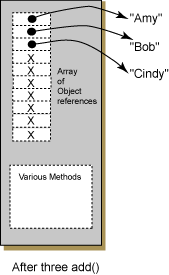You can encapsulate your integers in Integer objects
and store them in an ArrayList.

import java.util.* ;
public class ArrayListEg
{
public static void main ( String[] args)
{
// Create an ArrayList that holds references to String
ArrayList<String> names = new ArrayList<String>();
// Add three String references
names.add("Amy");
names.add("Bob");
names.add("Cindy");
// Access and print out the three String Objects
System.out.println("element 0: " + names.get(0) );
System.out.println("element 1: " + names.get(1) );
System.out.println("element 2: " + names.get(2) );
}
}
The example program creates an ArrayList that holds
String references and then adds references
to three Strings.
The statement
ArrayList<String> names = new ArrayList<String>();
creates an ArrayList of String references.
The phrase <String> can be read as "of String references".
There are "angle brackets" on each side of <String>.
The phrase ArrayList<String> describes both the type of the
object (an ArrayList) and the type of data it
holds (references to String).
ArrayList is a generic type.
Its constructor
specifies both the type of object to construct
and the type of data it holds.
The type of data is placed inside angle brackets
like this: <DataType>.
Now, when the ArrayList object is constructed, it will
hold data of type "reference to DataType".
A program must import the java.util
package to use ArrayList.
By default, an ArrayList starts out with 10 empty cells.
Examine the following:
ArrayList<Integer> values = new ArrayList<Integer>();
What type of data will values hold?